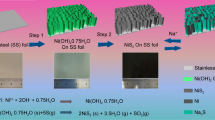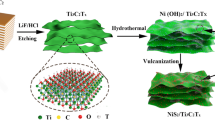Abstract
The NiS2 nanosheet array on Ni foil (NiS2/NF) was prepared using an in situ growth strategy and sulfidation method and was used as the cathode of lithium sulfur battery. The unique nanostructure of the NiS2 nanosheet array can provide abundant active sites for the adsorption and chemical action of polysulfides. Compared with the sulfur powder coated pure NF (pure NF-S) for lithium sulfur battery, the sulfur powder coated NiS2/NF (NiS2/NF-S) electrode exhibits superior electrochemical performance. Specifically, the NiS2/NF-S delivered a high reversible capacity of 1007.5 mAh g−1 at a current density of 0.1 C (1 C= 1675 mA g−1) and kept 74.5% of the initial capacity at 1.0 C after 200 cycles, indicating the great promise of NiS2/NF-S as the cathode of lithium sulfur battery. In addition, the NiS2/NF-S electrode also showed satisfactory electrochemical performance when used as the cathode for sodium sulfur battery.
Similar content being viewed by others
References
Tarascon J M, Armand M. Issues and challenges facing rechargeable lithium batteries. Nature, 2001, 414: 359–367
Kang B, Ceder G. Battery materials for ultrafast charging and discharging. Nature, 2009, 458: 190–193
Li S Y, Wei Y, Wang P, et al. Synergism of Cu and Al co-doping on improvements of structural integrity and electrochemical performance for LiNi0.5Mn1.5O4. J Alloys Compd, 2020, 820: 153140
Liu J, Zhang J G, Yang Z, et al. Materials science and materials chemistry for large scale electrochemical energy storage: From transportation to electrical grid. Adv Funct Mater, 2013, 23: 929–946
Ding Y, Cano Z P, Yu A, et al. Automotive Li-ion batteries: Current status and future perspectives. Electrochem Energ Rev, 2019, 2: 1–28
Wu H L, Zhang Y B, Deng Y Q, et al. A lightweight carbon nanofiber-based 3D structured matrix with high nitrogen-doping level for lithium metal anodes. Sci China Mater, 2019, 62: 87–94
Manthiram A, Fu Y, Chung S H, et al. Rechargeable lithium-sulfur batteries. Chem Rev, 2014, 114: 11751–11787
Manthiram A, Chung S H, Zu C. Lithium-sulfur batteries: Progress and prospects. Adv Mater, 2015, 27: 1980–2006
Li T, Bai X, Gulzar U, et al. A comprehensive understanding of lithium-sulfur battery technology. Adv Funct Mater, 2019, 29: 1901730
Li B Q, Kong L, Zhao C X, et al. Expediting redox kinetics of sulfur species by atomic-scale electrocatalysts in lithium-sulfur batteries. Infomat, 2019, 1: 533–541
Lee S K, Lee Y J, Sun Y K. Nanostructured lithium sulfide materials for lithium-sulfur batteries. J Power Sources, 2016, 323: 174–188
Seh Z W, Sun Y, Zhang Q, et al. Designing high-energy lithium-sulfur batteries. Chem Soc Rev, 2016, 45: 5605–5634
Cai D, Lu M, Li L, et al. A highly conductive MOF of graphene analogue Ni3(HITP)2 as a sulfur host for high-performance lithium-sulfur batteries. Small, 2019, 15: 1902605
Sun Y M, Seh Z W, Li W Y, et al. In-operando optical imaging of temporal and spatial distribution of polysulfides in lithium-sulfur batteries. Nano Energy, 2015, 11: 579–586
Wang D W, Zeng Q C, Zhou G M, et al. Carbon-sulfur composites for Li-S batteries: Status and prospects. J Mater Chem A, 2013, 1: 9382–9394
Xu J, Zhang W, Fan H, et al. Promoting lithium polysulfide/sulfide redox kinetics by the catalyzing of zinc sulfide for high performance lithium-sulfur battery. Nano Energy, 2018, 51: 73–82
Sun F, Zhou D, He X, et al. Morphological reversibility of modified Li-based anodes for next-generation batteries. ACS Energy Lett, 2020, 5: 152–161
Wu C, Huang H, Lu W, et al. Mg doped Li-LiB alloy with in situ formed lithiophilic LiB skeleton for lithium metal batteries. Adv Sci, 2020, 7: 1902643
Zhang L, Chen Z, Dongfang N, et al. Nickel-cobalt double hydroxide as a multifunctional mediator for ultrahigh-rate and ultralong-life Li-S batteries. Adv Energy Mater, 2018, 8: 1802431
Zu C X, Manthiram A. Hydroxylated graphene-sulfur nanocomposites for high-rate lithium-sulfur batteries. Adv Energy Mater, 2013, 3: 1008–1012
Cui Z M, Zu C X, Zhou W D, et al. Mesoporous titanium nitride-enabled highly stable lithium-sulfur batteries. Adv Mater, 2016, 28: 6926–6931
Chen T, Ma L B, Cheng B R, et al. Metallic and polar Co9S8 inlaid carbon hollow nanopolyhedra as efficient polysulfide mediator for lithium-sulfur batteries. Nano Energy, 2017, 38: 239–248
Yuan H D, Chen X L, Zhou G M, et al. Efficient activation of Li2S by transition metal phosphides nanoparticles for highly stable lithium-sulfur batteries. ACS Energy Lett, 2017, 2: 1711–1719
Babu G, Masurkar N, Al Salem H, et al. Transition metal dichalcogenide atomic layers for lithium polysulfides electrocatalysis. J Am Chem Soc, 2017, 139: 171–178
Wang Y Q, Luo S Q, Wang D Q, et al. Facile synthesis of three dimensional porous cellular carbon as sulfur host for enhanced performance lithium sulfur batteries. Electrochim Acta, 2018, 284: 400–407
Shi J L, Tang C, Huang J Q, et al. Effective exposure of nitrogen heteroatoms in 3D porous graphene framework for oxygen reduction reaction and lithium-sulfur batteries. J Energy Chem, 2018, 27: 167–175
Xing Z Y, Tan G Q, Yuan Y F, et al. Consolidating lithiothermic-ready transition metals for Li2S-based cathodes. Adv Mater, 2020, 32: 2002403
Guan B Y, Yu X Y, Wu H B, et al. Complex nanostructures from materials based on metal-organic frameworks for electrochemical energy storage and conversion. Adv Mater, 2017, 29: 1703614
Author information
Authors and Affiliations
Corresponding author
Additional information
This work was supported by the National Natural Science Foundation of China (Grant No. 21673051) and the Department of Science and Technology of Guangdong Province, China (Grant No. 2019A050510043).
Rights and permissions
About this article
Cite this article
Fan, M., Chen, Y., Ke, X. et al. In situ growth of NiS2 nanosheet array on Ni foil as cathode to improve the performance of lithium/sodium-sulfur batteries. Sci. China Technol. Sci. 65, 231–237 (2022). https://doi.org/10.1007/s11431-021-1860-x
Received:
Accepted:
Published:
Issue Date:
DOI: https://doi.org/10.1007/s11431-021-1860-x




